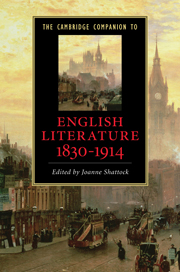Introduction
Published online by Cambridge University Press: 28 November 2010
Summary
This Cambridge Companion to English Literature 1830-1914 comprises a series of newly commissioned essays that offer fresh perspectives on a literary period bounded at one end by the Romantic movement and by Modernism at the other. Debates about periodization, as we know, can be both intense and contentious. The parameters of what has become known as the 'long' nineteenth century and the divisions within it are regularly contested. Studies of Romanticism have variously adopted the 1770s or 1789 as their starting point, tracing the origins of the movement in the poetry of the late eighteenth century or highlighting the French Revolution as the context for an equally revolutionary period in literature. The transition to the Victorian period is generally marked by the end of the 1820s, the decade that witnessed the deaths of the second generation of Romantic poets, with 1832, the year of the first Reform Bill, sometimes chosen as the end date, rather than 1830.
The Victorian period has similarly porous boundaries. The dates of Queen Victoria’s reign, 1837-1901, are sometimes adopted, as in the volume of The New Cambridge History of English Literature, which follows the divisions of the original CHEL (1907-27), although arguments about the artificiality of these dates are vigorous. The century (1800-1900) is sometimes used to circumscribe an area of study, as in the recent volume of the third edition of Cambridge Bibliography of English Literature (1999), which followed the pattern established by the original CBEL in 1940. Opposition to this particular arrangement turns on the differences between Romantic and Victorian writing and the need to recognize their distinctiveness as well as the unsatisfactory nature of century divisions in literary study.
- Type
- Chapter
- Information
- Publisher: Cambridge University PressPrint publication year: 2010



